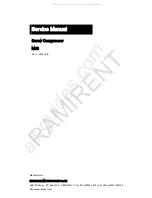
8
Air-Cooled Heat Exchangers
Air-cooled heat exchangers must be sized to provide adequate cooling under the most severe conditions, which probably
means providing for an ambient temperature of 40°C. Once the cooler is in place and working, precautions must be taken
to prevent restriction of the cooling air flow to and from the cooler and recirculation of the cooling air.
Safety Valves
Safety valves are pressure relief valves and should be sized and purchased with a pressure setting to protect the weakest link
in the system. Never change the pressure setting. Only the safety valve manufacturer or certified ASME valve repair shop
is qualified to make a change.
Safety valves are to be placed ahead of any potential blockage point which includes, but is not limited to, shutoff valves,
heat exchangers, pulsation dampeners, and discharge silencers. Ideally the safety valve should be threaded directly into the
pressure point it is sensing, not connected with tubing or pipe, and pointed away from any chance bystander.
The safety valve shall prevent pressure in the weakest component from exceeding 110% of the maximum allowable working
pressure during maximum flow conditions but must not be set higher than the maximum working pressure of the weakest
link. Failure to properly size, set and install pressure relief valves can be fatal.
Pressure Vessels
Air receiver tanks and other pressure containing vessels, such as, but not limited to, pulsation bottles, heat exchangers,
moisture separators and traps, shall be in accordance with ASME Boiler and Pressure Vessel Code, Section VIII, and/or
Provincial Boiler Branch Requirements. Failure to adhere to these codes can be fatal. Most Governments keep track of all
pressure vessels. Yours should be subject to an inspection by authorities.
Electrical
Before installation, the electrical supply should be checked for adequate wire size and transformer capacity. During
installation a suitably fused or circuit breaker disconnect switch and motor starter should be provided. Where a 3-phase
motor is used to drive a compressor any unreasonable voltage unbalance between the legs must be reduced and any low
voltage corrected to prevent excessive current draw. The installation, electric motor, wiring and all electrical controls must
be in accordance with ANSI Cl National Electric Code, ANSI C2 National Electric Safety Code, State/Provincial and
Local Codes. All electrical work should be performed by a qualified electrician. Failure to abide by the codes may result in
physical harm and/or property damage.
Guards
All mechanical action or motion is hazardous in varying degrees and needs to be guarded. Guarding shall be in compliance
with OSHA Safety and Health Standards 29 CFR 1910.219 in OSHA Manual 2206, Revised November 7, 1978 and any
Provincial, State or Local Codes.
Guards, if supplied, must be fastened in place before starting the machine and never be removed before switching off and
locking out the main power supply.
Manual Relief and Shutoff Valves
Install a manual relief valve to vent the compressor and the compressor discharge line to atmosphere. In those instances
where the air receiver tank services a single compressor, such as a tank-mounted unit, the manual relief valve can be
installed in the receiver. Where a manual shut-off valve (block valve) is used manual relief shall be installed upstream from
the manual shut-off valve (block valve), and a safety relief valve installed upstream from the manual relief valve. These
valves are to be designed and installed as to permit maintenance to be performed in a safe manner. Never substitute a check
valve for a manual shut-off valve (block valve) if it is the purpose of the manual shut-off valve to isolate the compressor
unit from a system for servicing.
Summary of Contents for RECIPROCATING
Page 2: ...2 ...
Page 15: ...15 TROUBLESHOOTING AND REPAIR ...
Page 16: ...16 TROUBLESHOOTING AND REPAIR ...
Page 17: ...17 TROUBLESHOOTING AND REPAIR ...
Page 19: ...19 ...






































